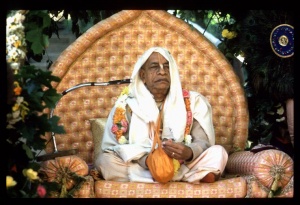CC Madhya 6.135 (1975)

A.C. Bhaktivedanta Swami Prabhupada
Below is the 1996 edition text, ready to be substituted with the 1975 one using the compile form.
TEXT 135
- pramāṇera madhye śruti pramāṇa—pradhāna
- śruti ye mukhyārtha kahe, sei se pramāṇa
SYNONYMS
pramāṇera—of the evidences; madhye—in the midst; śruti—the Vedic version; pramāṇa—evidence; pradhāna—chief; śruti—the Vedic version; ye—whatever; mukhya-artha—chief meaning; kahe—says; sei se—that indeed; pramāṇa—evidence.
TRANSLATION
“Although there is other evidence, the evidence given in the Vedic version must be taken as foremost. Vedic versions understood directly are first-class evidence.”
PURPORT
Works that should be consulted are Śrīla Jīva Gosvāmī’s Tattva-sandarbha (10-11), Śrīla Baladeva Vidyābhūṣaṇa’s commentary on that, and the following verses of the Brahma-sūtra: śāstra-yonitvāt (Vs. 1.1.3), tarkāpratiṣṭhānāt (Vs. 2.1.11) and śrutes tu śabda-mūlatvāt (Vs. 2.1.27), as commented upon by Śrī Rāmānujācārya, Śrī Madhvācārya, Śrī Nimbārkācārya and Śrīla Baladeva Vidyābhūṣaṇa. In his book Sarva-saṁvādinī, Śrīla Jīva Gosvāmī has noted that although there are ten kinds of evidence—direct perception, the Vedic version, historical reference, hypothesis and so on—and although they are all generally accepted as evidence, the person presenting a hypothesis, reading the Vedic version, perceiving or interpreting by his experience is certain to be imperfect in four ways. That is, he is subject to committing mistakes, to becoming illusioned, to cheating and to having imperfect senses. Although the evidence may be correct, the person himself is in danger of being misled due to his material defects. Apart from the direct presentation, there is a chance that an interpretation may not be perfect. Therefore the conclusion is that only a direct presentation can be considered evidence. An interpretation cannot be accepted as evidence, but may be considered proof of evidence.
In the Bhagavad-gītā, at the very beginning it is stated:
- dhṛtarāṣṭra uvāca
- dharma-kṣetre kuru-kṣetre samavetā yuyutsavaḥ
- māmakāḥ pāṇḍavāś caiva kim akurvata sañjaya
(BG 1.1)
The statements of the Bhagavad-gītā are themselves proof that there is a place of religious pilgrimage named Kurukṣetra where the Pāṇḍavas and Kurus met to fight. After meeting there, what did they do? This was Dhṛtarāṣṭra’s inquiry to Sañjaya. Although these statements are very clear, atheists try to interpret different meanings of the words dharma-kṣetra and kuru-kṣetra. Therefore Śrīla Jīva Gosvāmī has warned us not to depend on any kind of interpretation. It is better to take the verses as they are, without interpretation.